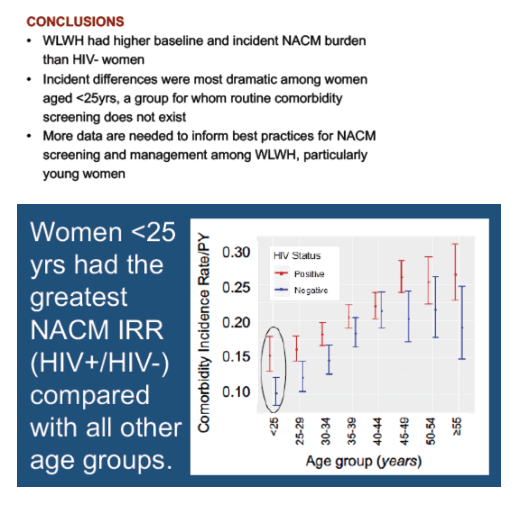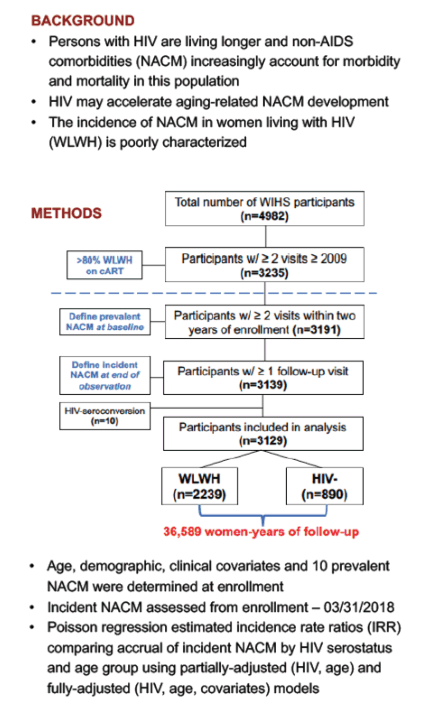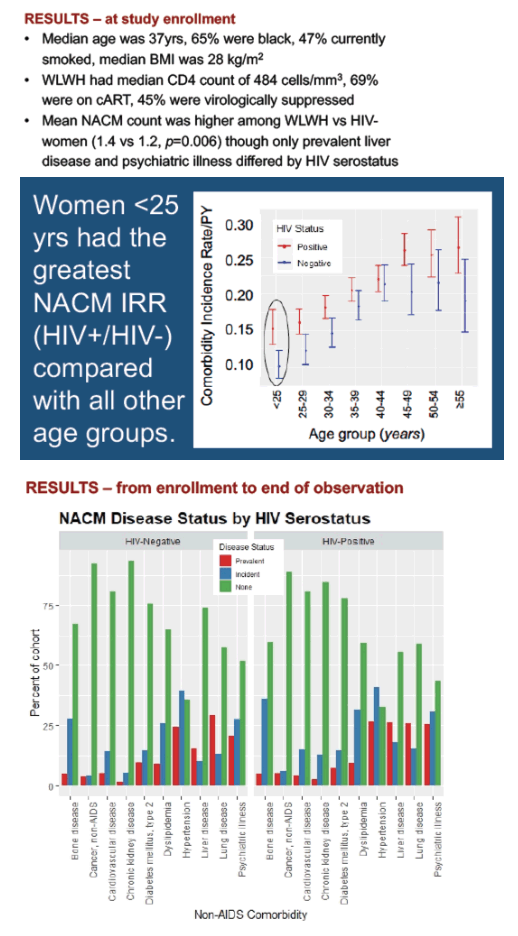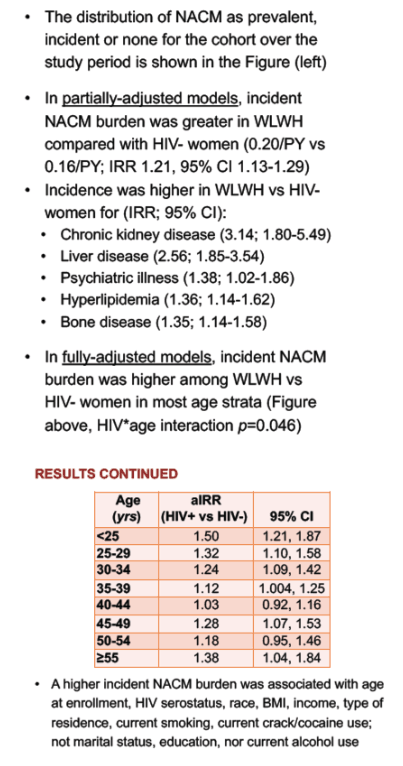 |
 |
 |
| |
Women with HIV Have High Overall Burden and Early Accrual of Non-AIDS Comorbidities
|
| |
| |
"HIV infection may accelerate aging-related comorbidity development. The incidence of non-AIDS comorbidities (NACM) in women with HIV (WWH) is poorly characterized."
CROI 2020
Reported by Jules Levin
Lauren F. Collins1, Anandi N. Sheth1, C. Christina Mehta1, Elizabeth T. Golub2, Phyllis Tien3, Kathryn Anastos4, Audrey French5, Seble Kassaye6, Tonya Taylor7,
Mirjam-Colette Kempf8, Margaret Fischl9, Adaora Adimora10, Frank J. Palella11, Igho Ofotokun1
1Emory University, Atlanta, GA, USA, 2Johns Hopkins Bloomberg School of Public Health, Baltimore, MD, USA, 3University of California San Francisco, San Francisco, CA, USA, 4Albert Einstein College of Medicine, Bronx, NY, USA, 5John H. Stroger Jr. Hospital of Cook County, Chicago, IL, USA,
6Georgetown University, Washington, DC, USA, 7SUNY Downstate Medical Center, Brooklyn, NY, USA, 8University of Alabama at Birmingham, Birmingham, AL, USA, 9University of Miami, Miami, FL, USA, 10University of North Carolina at Chapel Hill, Chapel Hill, NC, USA, 11Northwestern University, Chicago, IL, USA

program abstract
HIV infection may accelerate aging-related comorbidity development. The incidence of non-AIDS comorbidities (NACM) in women with HIV (WWH) is poorly characterized.
WWH and HIV- women in active follow-up in the Women's Interagency HIV Study (WIHS) in 2009 (when >80% of WWH used antiretroviral therapy (ART)) or onward were included, with outcomes measured through March 31, 2018. Age, demographic and clinical covariates, and prevalent NACM were determined at enrollment. We used Poisson regression to estimate incidence rate ratios (IRR) comparing accrual of incident NACM by HIV serostatus and age using partially adjusted (age, HIV) and fully adjusted (age, HIV, covariates) models.
There were 3129 women (2239 HIV+, 890 HIV-) with 36,589 person-yrs (PY) of follow-up. At enrollment, median age was 37yrs, 65% were black, 47% currently smoked, and median body mass index was 28 kg/m2. WWH had a median CD4 count of 484 cells/mm3, 69% were on ART and 45% were virologically suppressed. Of 10 NACM evaluated, mean NACM count at enrollment was higher among WWH vs HIV- women (1.4 vs 1.2, p=0.006), though only prevalent liver disease (26% vs 16%, p<0.001) and psychiatric illness (26% vs 21%, p=0.003) differed significantly by HIV serostatus. In partially adjusted models, incident NACM burden was greater in WWH vs HIV- women (0.20/PY vs 0.16/PY; IRR 1.21, 95% CI 1.13-1.29) and increased with age regardless of HIV serostatus (p<0.0001). Incidence was higher in WWH vs HIV- women for (IRR; 95% CI): chronic kidney (3.14; 1.80-5.49), liver (2.56; 1.85-3.54), psychiatric (1.38; 1.02-1.86), hyperlipidemia (1.36; 1.14-1.62) and bone disease (1.35; 1.14-1.58). The incidence of hypertension, diabetes, cardiovascular, lung disease and non-AIDS cancer did not differ significantly by HIV serostatus. In fully adjusted models, incident NACM burden was significantly higher among WWH vs HIV- women in most age strata (Figure, HIV*age interaction p=0.046). Women <25yrs had the greatest IRR at 1.50 (95% CI 1.21-1.87) vs those 25-29 (1.32; 1.10-1.58), 30-34 (1.24; 1.09-1.42), 35-39 (1.12; 1.00-1.25), 40-44 (1.03; 0.92-1.16), 45-49 (1.28; 1.07-1.53), 50-54 (1.18; 0.95-1.46), 55 (1.38; 1.04-1.84).
WWH have higher baseline and incident NACM burden than HIV- women. Incident differences were most dramatic among women aged <25yrs, a group for whom routine comorbidity screening is lacking. More data are needed to inform best practices for NACM screening and management in WWH, particularly young women.




|
| |
|
 |
 |
|
|